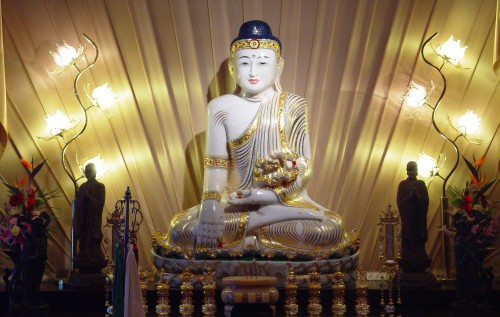Prince Siddhartha was born more than three thousand years ago. At his birth, a wise man, Asita predicted that the prince would either grow up to be a great king, or leave the palace to become an enlightened one, a savior of all sentient beings. His father, King Suddodana was alarmed by this prophecy. Wishing for his son to become a worldly ruler like himself, the king surrounded his son with luxuries, and provided him everything a child would ever need or want. When the prince was sixteen, the King arranged for him to marry a beautiful Princess. He hoped Siddhartha would be too preoccupied with starting a family of his own in this opulent environment to ever wonder if there was more to life.
Prince Siddhartha wondered about the life outside the palace. Eventually, during a city visit, he witnessed people suffering from old age, sickness, and death. These sights troubled and alarmed Siddhartha. He was overcome with sorrow, realizing that everyone would suffer painful illnesses, become old, frail, and die. He was determined to find a way to end this suffering. Prince Siddhartha decided that he must leave his riches, father, wife and newborn son to seek the Truth of life and death in order to find peace, liberation and enlightenment. He donned the saffron robe, cut off his hair and left his family and palace life.
Siddhartha went to different teachers to learn meditation and ascetic practice. He mastered all the levels of meditative absorption. Yet even after attaining the highest levels of concentration and deepest levels of pain and suffering from hunger and discomfort, he realized he was still not free. He saw that neither of these states was the ultimate enlightenment: that which is beyond birth and death.
Siddhartha then gave up the extreme ascetic discipline to follow a middle path of practicing moderation. He begged for food and rebuilt his body for the next great event in his sacred journey. Siddhartha sat beneath a Bodhi tree and vowed, “Even if my blood dries up and my skin and bones waste away, I will not leave this seat until I have attained supreme enlightenment, the Truth of life and death, and the end of suffering for all mankind!”
As he sat there with unwavering determination, while doubts, desire, craving, and fear arose, Siddhartha sat firm and did not allow these thoughts to disturb his concentration. Instead, he simply let them go. Eventually, after a long time, Siddhartha realized, “Wonders of wonders, all sentient beings are intrinsically complete and perfect, but they do not recognize it because of their delusions and attachments.”
Siddhartha realized the impermanence of life, and how living beings die only to be reborn in accordance with their karma. All beings are caught in the same round of existence due to greed and ignorance. He realized the cause of all evil and suffering and how to be released from it. He understood how to be liberated from sorrow, unhappiness, suffering, old age, and death. He had become a Buddha, the Awakened One.
The Buddha began “turning the Dharma Wheel”, and taught mankind the paths to attain liberation such as the Four Noble Truths, the Eightfold Path, the Principle of Causality, Dependent Origination, Emptiness, the Six Paramitas, and the Middle Way. The Buddha taught for 49 years, always patient, compassionate, wise, and never in anger. He lived up to his teachings to perfection. He entered nirvana at the age of 80. His chief disciples, such as the Venerable Mahakasyapa and Ananda collected Buddha’s verbal teachings for future generations. You can learn more about the Buddha’s teachings at Buddha Gate Monastery. Classes in Meditation and Buddhism are free, ongoing and open to the public.

